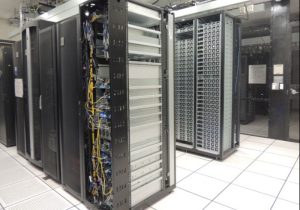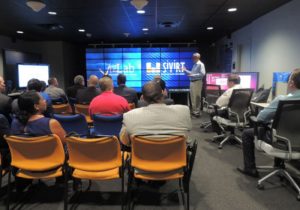 Technology departments have moved far beyond break fix solutions. Across industries, IT is asked to develop innovative solutions that support enterprise needs surpassing standard computing to support the mission and vision of the organization. At UTSA this often means research.
Technology departments have moved far beyond break fix solutions. Across industries, IT is asked to develop innovative solutions that support enterprise needs surpassing standard computing to support the mission and vision of the organization. At UTSA this often means research.
The Office of Information Technology’s (OIT) Research Computing Support Group (RCSG) was formed by a committee of faculty researchers with support from OIT to provide necessary support for UTSA researchers who are dependent on high performance computing.
The RCSG, led by Director of Research Computing Support and Innovative Solutions Brent League supports UTSA’s research community by facilitating growth, enabling productivity and innovation, maintaining and supporting the Research Data Center, offering High Performance Computing solutions and managing the UTSA Advanced Visualization Lab (VizLab).
High Performance Computing Support and Tier One
One of the goals of the university is to reach Tier One research intuition status. Across disciplines from art to neuroscience, research has increased and similarly the requirement to have tools to collect and interpret large data sets. The RCSG’s main goal is to support world class researchers, which directly supports the 2020 Blueprint priority of innovative research and discovery. The 2020 Blueprint, which builds upon the university’s strategic plan was developed to maintain the momentum toward Tier One which was seen with the 2016 Shared vision.
The UTSA Research Data Center houses high performance computing equipment that are categorized as UTSA research or grant funded. Through RCSG, faculty and student researchers now have access to computing, storage and visualization resources to support research that has specialized or highly intensive computation, storage, bandwidth or graphics requirements. “In the past, faculty researchers were encumbered with providing technical support for their computer systems,” stated Brent League, “but now OIT’s Research Computing Support Group has stepped in to fill that role, leaving faculty researchers to focus on the scientific goals of their research.”
Interactive Collaborative and Innovative Tools
Previously a showcase for technology, with the RCSG team’s support the VizLab is now a core research facility that allows researchers from all disciplines of art, science and engineering to conduct simulation and visualization research to better understand complex phenomena and translate data into images on large-scale and high resolution visualization walls or other display devices. The laboratory is staffed by OIT RCSG and supports UTSA’s mission of teaching, research and community engagement and contributes to UTSA’s goal to recruit the world’s top computational researchers.
There are several resources available through the VizLab including:
- The VizWall, the VizLab’s 14.4’ by 6’ tall visualization wall. It is comprised of 24 high-definition (HD) 30” monitors and has a maximum resolution of 98 million pixels.
- SHAMU, which is the largest high performance computation cluster at the university. It consists of 80 computation nodes, 1328 CPU Cores, 16 TB of shared memory and 96 TB of shared storage.
- NEMO, a high performance computation cluster for the VizLab. It consists of 12 computational nodes and is powered by dual Hex-Core Intel Xeon X5660 2.80 GHz processors (12M Cache) and dual nVIDIA Quadro FX 5800 graphics cards (4GB each).
- Haptic manipulators, which provide researchers and students a tactile experience with virtual models in computer-generated simulations.
- Oculus Rift virtual reality (VR) headsets, which use state-of-the-art displays and optics designed specifically for VR.
- Z Space, an interactive 3D teaching tablet that allows users to visualize, create and experience in ways beyond the traditional computation environment.
 The RCSG is working to make sure that the technology available is not simply perceived as a novelty but are teaching tools that can be used to create interactive approaches to learning and research. The technology and resources are available at no additional cost to faculty and students. An increase in interest and use of these impressive resources to enhance and expand research at UTSA is anticipated. From research on interactive teaching visualizing Maya and other architectural sites to predicting tumor growth, the research possibilities are endless.
The RCSG is working to make sure that the technology available is not simply perceived as a novelty but are teaching tools that can be used to create interactive approaches to learning and research. The technology and resources are available at no additional cost to faculty and students. An increase in interest and use of these impressive resources to enhance and expand research at UTSA is anticipated. From research on interactive teaching visualizing Maya and other architectural sites to predicting tumor growth, the research possibilities are endless.
UTSA Advanced Visualization Laboratory is managed by the Office of Information Technology and has been funded by the National Science Foundation under the Major Research Instrumentation Program.
